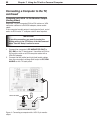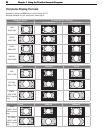
88 Chapter 7. Using the TV with a Personal Computer
Setup
1. See the TV specifications in Appendix B to confirm
that your computer video signal is compatible with the
TV.
2. Note whether the computer supplies a digital or
analog video signal. You will need this information
during the setup procedure.
• Digital video signal: Comes from the computer’s
DVI or HDMI output.
• Analog video signal: Comes from the computer’s
VGA 15-pin output and requires a VGA-to-DVI
cable or a VGA cable and VGA/DVI adapter.
3. Power on the TV.
IMPORTANT
In the next step, select the correct video signal
type (analog or digital) in the NetCommand
menu. Otherwise, the TV will be unable to
display a picture from the computer.
4. Press
MENU
to open the Main menu, highlight the
NetCommand icon, and press
ENTER
.
5. Highlight the PC-DVI text box and press to change
the setting to match your computer’s video signal
type, either Digital or Analog.
Figure 1. Specify your computer’s video signal type
(analog or digital) in the NetCommand menu.
6. Press
EXIT
to close all menus.
7. Connect the computer’s video output to the TV’s
PC
-
DVI
jack. See the connection diagrams in this
chapter to find the method best suited to your equip-
ment.
8. Connect the computer’s audio output using one of
these options:
• Connect analog left/right audio to the TV’s
PC-DVI AUDIO
jack.
• If your computer offers digital audio output,
connect it to a digital A/V receiver instead.
IMPORTANT
See Appendix B for signal compatibility.
Note
• The
PC-DVI
input on the TV can accept either
analog (DVI-A) or digital (DVI-D) signals.
•
You must specify the PC DVI Input setting in the
NetCommand menu as either Analog or Digital,
depending on the signal type sent by your computer.
• If your computer offers digital audio output, you can
connect your computer’s digital audio out to a digital
input on a digital A/V receiver.
Video Adjustments
1. Power on the computer if it is not already on.
2. Select PC from the Input Selection menu. To do this,
press
INPUT
to open the Input Selection menu, move the
highlight to the PC icon, and press
ENTER.
3. Change the resolution of the computer image. The
goal is to maximize the computer resolution while
maintaining a suitable aspect ratio for the image. See
the explanation later in this chapter.
4. Perform TV video adjustments. Press
VIDEO
repeat-
edly to cycle through the video-adjustment options.
The following additional adjustments are available for
computer video:
Auto Position. Press
ENTER
to automatically center
the position of the PC video.
HorizPosition (Horizontal Position). Manually
adjust the horizontal position of the PC. This
selection overrides the Auto Position selection.
VertPosition (Vertical Position). Manually adjust
the vertical position of the PC. This selection
overrides the Auto Position selection.
Fine Detail (analog DVI-A signals only). Manually
adjust the picture quality of the PC. This selection
overrides the Auto Position selection.
5. Change the TV picture format to suit the image.
Press
FORMAT
to cycle through the available picture
formats. See the chart later in this chapter showing
how various computer resolutions are displayed on
the TV.
To Remove the Computer Icon from
the Input Selection Menu
When you disconnect an analog video connection from
a personal computer, the computer icon remains in the
Input Selection menu until you remove it.
1. I
n the NetCommand menu, highlight the PC DVI Input box.
2. Highlight the PC DVI Input box and press to select
Digital.
3. Press
EXIT
to close all menus.
The next time you open the Input Selection menu, the
computer icon will no longer appear.


















